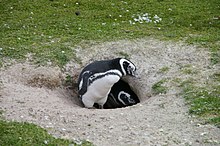Magellanic penguin
| Magellanic penguin | ||||||||||
|---|---|---|---|---|---|---|---|---|---|---|

Magellanic penguin ( Spheniscus magellanicus ) |
||||||||||
| Systematics | ||||||||||
|
||||||||||
| Scientific name | ||||||||||
| Spheniscus magellanicus | ||||||||||
| ( Forster , 1781) |
The Magellan Penguin ( Spheniscus magellanicus ) is a bird art in the genus of penguins ( Spheniscus ). It occurs in the south of South America . The species received its scientific name because of its abundance on the coasts of the "Terra Magellanica", which roughly corresponds to the area of Patagonia .
Appearance
The Magellanic penguin is about 70 cm long and weighs four kilograms. The head and top of the torso, wings and tail are black. The underside of the fuselage and the wings are white, but there are a few irregularly distributed black dots here. A white stripe runs from the throat in a curved arc over the neck and behind the cheek to the stripe above the eyes to the base of the beak. The white border of the eye unites with this super-eye stripe. From the base of the beak, a small white drop pulls up to eye level. In the front above the eye to the base of the beak, the plumage is slightly pink. A black band extends from the chest on the flanks to the legs, in front of which it tapers and ends clearly in front of the feet. The iris is dark red, the legs are skin-colored with black skin scales on top. The beak is mostly black and irregularly colored horn-colored. Females are insignificantly smaller than males and do not differ in their plumage. The second downy plumage of the young birds is gray-brown and white on the chest, belly and throat. There is a light area around the eyes and on the cheeks that connects to the white throat. Fledglings are very similar to adult birds.
Distribution, existence and endangerment
The Magellanic penguin occurs on the rocky coasts of the Falkland Islands , in Chile , Argentina , Uruguay and partly in southern Brazil . There are over 100,000 breeding pairs on the Falkland Islands and 650,000 breeding pairs on the coasts of Argentina. The total population is estimated by the IUCN to be around 1.3 million breeding pairs. The population is particularly endangered by oil pollution of the seawater, but hunting and overfishing also play a role, so that the IUCN classifies the Magellanic penguin as a type of warning list ("near threatened").
Reproduction
Females brood from the age of four, males from 5 years. To do this, the Magellanic penguin digs a breeding cave if the ground allows it. Otherwise it breeds in small hollows, crevices or under bushes. The females appear at the breeding site in September, and egg-laying begins around mid-October. The two eggs of the same size are laid four days apart and each weigh about 125 g. They are incubated for about 40 days. The female hatches first, while the male hunts up to 500 km from the hatchery. It loosens the female after 15 to 20 days. The female then goes hunting.
After the young have hatched, the partners take turns huddling each day . One parent takes turns hunting in the morning and returning later in the day so that the young are fed once a day. During this time, the parents hunt about 40 km from the hatchery. The hunt lasts longer as the young birds get bigger because they need more food. The young birds sometimes only get food after a few days.
Although the two eggs are the same size, the parents prefer to feed the young bird that hatches first. This leads to a higher mortality rate for the second young bird. However, the parents can successfully raise two young birds if they can provide enough food.
After 30 days the young birds have their second down plumage and can leave the breeding cave. They do not form youth groups because the breeding cave offers them good protection from the cold and enemies.
When it rains heavily, the young birds can get wet and cool down, as the juvenile plumage is not water-repellent and when wet, it loses its heat-insulating properties. The young birds can then die of hypothermia. In rare cases, they can drown in the brood cavity.
At 9 to 17 weeks, the young birds are fully fledged, depending on their food.
food
Magellanic penguins feed mainly on fish (e.g. Micromesistius australis , Sprattus fuegensis , Engraulis anchoita and Merluccius hubbsi ), squids ( Loligo gahi , Gonatus antarcticus , Moroteuthis ingens and Onychoteuthis sp. ) And krill ( Munida gregaria ) in roughly the same way Shares. The hunt takes place in water depths of up to about 50 meters, but can go up to a maximum of 100 meters. In winter, the Magellanic penguins can also come to the coasts of northern Brazil in search of food.
literature
- Mike Bingham: Penguins of the Falkland Islands & South America , pp. 48-51, 2001, ISBN 0-7596-3335-5
Web links
- Spheniscus magellanicus in the endangered Red List species the IUCN 2008. Posted by: BirdLife International, 2008. Accessed October 22 of 2008.
- Videos, photos and sound recordings of Spheniscus magellanicus in the Internet Bird Collection


